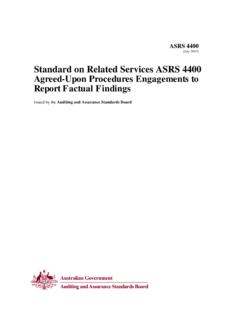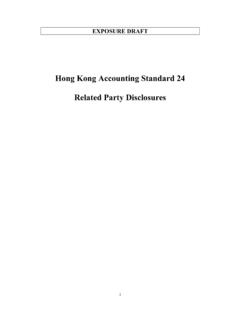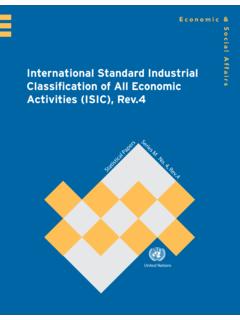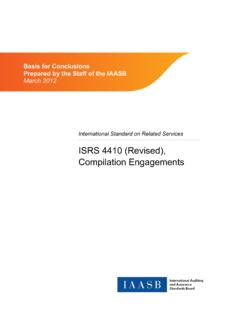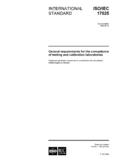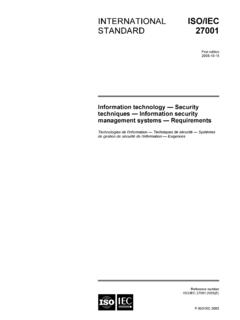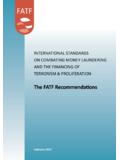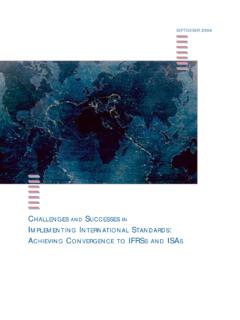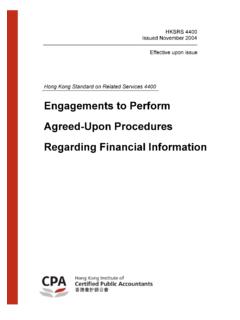Transcription of INTERNATIONAL ISO STANDARD 140-4 - USB Bog
1 AReference numberISO 140-4 :1998(E)INTERNATIONALSTANDARDISO140 -4 Second edition1998-08-15 Acoustics Measurement of soundinsulation in buildings and of buildingelements Part 4:Field measurements of airborne soundinsulation between roomsAcoustique Mesurage de l isolation acoustique des immeubles et des l ments de construction Partie 4: Mesurage in situ de l isolement aux bruits a riens entre les pi cesLicensed to PO BOX Internatoinal / Ms. MejiaISO Store order #: 10-1221820/Downloaded: 2011-08-23 Single user licence only, copying and networking prohibitedISO 140-4 :1998(E) ISO 1998 All rights reserved. Unless otherwise specified, no part of this publication may be reproducedor utilized in any form or by any means, electronic or mechanical, including photocopying andmicrofilm, without permission in writing from the Organization for StandardizationCase postale 56 CH-1211 Gen ve 20 in SwitzerlandiiForewordISO (the INTERNATIONAL Organization for Standardization) is a worldwidefederation of national standards bodies (ISO member bodies).
2 The work ofpreparing INTERNATIONAL standards is normally carried out through ISOtechnical committees. Each member body interested in a subject for whicha technical committee has been established has the right to be representedon that committee. INTERNATIONAL organizations, governmental and non-governmental, in liaison with ISO, also take part in the work. ISOcollaborates closely with the INTERNATIONAL Electrotechnical Commission(IEC) on all matters of electrotechnical INTERNATIONAL standards adopted by the technical committees arecirculated to the member bodies for voting. Publication as an InternationalStandard requires approval by at least 75 % of the member bodies castinga STANDARD ISO 140-4 was prepared by Technical CommitteeISO/TC 43, Acoustics, Subcommittee SC 2, Building second edition cancels and replaces the first edition (ISO 140-4 :1978)which has been technically 140 consists of the following parts, under the general title Acoustics Measurement of sound insulation in buildings and of building elements: Part 1: Requirements of laboratory test facilities with suppressedflanking transmission Part 2: Determination, verification and application of precision data Part 3: Laboratory measurement of airborne sound insulation ofbuilding elements Part 4: Field measurements of airborne sound insulation betweenrooms Part 5.
3 Field measurements of airborne sound insulation of fa adeelements and fa ades Part 6: Laboratory measurements of impact sound insulation of floorsLicensed to PO BOX Internatoinal / Ms. MejiaISO Store order #: 10-1221820/Downloaded: 2011-08-23 Single user licence only, copying and networking prohibited ISOISO 140-4 :1998(E)iii Part 7: Field measurements of impact sound insulation of floors Part 8: Laboratory measurements of the reduction of transmittedimpact noise by floor coverings on a heavyweight STANDARD floor Part 9: Laboratory measurement of room-to-room airborne soundinsulation of a suspended ceiling with a plenum above it Part 10: Laboratory measurement of airborne sound insulation ofsmall building elementsAnnexes A and B form an integral part of this part of ISO 140. Annexes Cto F are for information to PO BOX Internatoinal / Ms.
4 MejiaISO Store order #: 10-1221820/Downloaded: 2011-08-23 Single user licence only, copying and networking prohibitedLicensed to PO BOX Internatoinal / Ms. MejiaISO Store order #: 10-1221820/Downloaded: 2011-08-23 Single user licence only, copying and networking prohibitedINTERNATIONAL STANDARD ISOISO 140-4 :1998(E)1 Acoustics Measurement of sound insulation in buildings and ofbuilding elements Part 4:Field measurements of airborne sound insulation between rooms1 ScopeThis part of ISO 140 specifies field methods for measuring the airborne sound insulation properties of interior walls,floors and doors between two rooms under diffuse sound field conditions in both rooms, and for determining theprotection afforded to the occupants of the methods give values for airborne sound insulation which are frequency dependent. They can be converted intoa single number, characterizing the acoustic performance, by application of ISO results obtained can be used to compare sound insulation between rooms and to compare actual soundinsulation with specified 1 Laboratory measurements of airborne sound insulation of building elements are dealt with in ISO 2 Field measurements of airborne sound insulation of fa ade elements and fa ades are dealt with in ISO Normative referencesThe following standards contain provisions which, through reference in this text, constitute provisions of this part ofISO 140.
5 At the time of publication, the editions indicated were valid. All standards are subject to revision, andparties to agreements based on this part of ISO 140 are encouraged to investigate the possibility of applying themost recent editions of the standards indicated below. Members of IEC and ISO maintain registers of currently validInternational 140-2:1991, Acoustics Measurement of sound insulation in buildings and of building elements Part 2:Determination, verification and application of precision 140-3:1995, Acoustics Measurement of sound insulation in buildings and of building elements Part 3:Laboratory measurements of airborne sound insulation of building 354:1985, Acoustics Measurement of sound absorption in a reverberation 717-1:1996, Acoustics Rating of sound insulation in buildings and of building elements Part 1: Airbornesound 60651:1979, Sound level 60804:1985, Integrating-averaging sound level to PO BOX Internatoinal / Ms.
6 MejiaISO Store order #: 10-1221820/Downloaded: 2011-08-23 Single user licence only, copying and networking prohibitedISO 140-4 :1998(E) ISO2 IEC 60942: 1988, Sound 61260:1995, Electroacoustics Octave band filters and fractional-octave band DefinitionsFor the purposes of this part of ISO 140, the definitions given in ISO 140-3 and following definitions average sound pressure level in a room, L: Ten times the logarithm to the base 10 of the ratio of the spaceand time average of the sound pressure squared to the square of the reference sound pressure, the space averagebeing taken over the entire room with the exception of those parts where the direct radiation of a sound source orthe near field of the boundaries (wall, etc.) is of significant influence; it is expressed in practice, usually the sound pressure levels Lj are measured. In this case L is determined byLnLjnj= = 10110101lgdB.
7 (1)where Lj are the sound pressure levels L1 to Ln at n different positions in the level difference, D: Difference, in decibels, in the space and time average sound pressure levels produced intwo rooms by one or more sound sources in one of them:DL L= 12.. (2)whereL1is the average sound pressure level in the source room;L2is the average sound pressure level in the receiving normalized level difference, Dn: Level difference, in decibels, corresponding to the reference absorption areain the receiving room:DDAA nlgdB= 100.. (3)whereDis the level difference, in decibels;Ais the equivalent sound absorption area of the receiving room, in square metres;A0is the reference absorption area, in square metres (for rooms in dwellings or rooms of comparable size:A0 = 10 m2). standardized level difference, DnT: Level difference, in decibels, corresponding to a reference value of thereverberation time in the receiving room:DDTTT nlgdB=+100.
8 (4)whereDis the level difference;Licensed to PO BOX Internatoinal / Ms. MejiaISO Store order #: 10-1221820/Downloaded: 2011-08-23 Single user licence only, copying and networking prohibited ISOISO 140-4 :1998(E)3 Tis the reverberation time in the receiving room;T0is the reference reverberation time; for dwellings, T0 = 0,5 1 The standardizing of the level difference to a reverberation time of 0,5 s takes into account that in dwellings withfurniture the reverberation time has been found to be reasonably independent of the volume and of frequency and to beapproximately equal to 0,5 s. With this standardizing, DnT is dependent on the direction of the sound transmission if the tworooms have different 2 The standardizing of the level difference to the reverberation time in the receiving room of T0 = 0,5 s is equivalent tostandardizing the level difference with respect to a reference absorption area ofA0 = 0,32 VwhereA0is the reference absorption area, in square metres.
9 Vis the volume of the receiving room, in cubic apparent sound reduction index R : Ten times the logarithm to the base 10 of the ratio of the sound powerW1 which is incident on a partition under test to the total sound power transmitted into the receiving room if, inaddition to the sound power W2 transmitted through the separating element, the sound power W3, transmittedthrough flanking elements or by other components, is significant; it is expressed in decibels:RWWW'=+10123lgdB.. (5)NOTE 1 Explanations of W3 are given in annex 2 The expression "apparent sound transmission loss" is also in use in English-speaking countries. It is equivalent to"apparent sound reduction index".NOTE 3 In general, the sound power transmitted into the receiving room consists of the sum of several components.
10 Also inthis case, under the assumption that there are sufficiently diffuse sound fields in the two rooms, the apparent sound reductionindex in this part of ISO 140 is evaluated fromRDSA'=+10 lgdB.. (6)whereDis the level difference;Sis the area of the separating element;Ais the equivalent sound absorption area in the receiving the case of determination of the sound reduction of a door, S is the area of the free opening in which the door including theframe is mounted. It has to be proved that the sound transmission through the rest of the surrounding wall is the case of staggered or stepped rooms, S is that part of the area of the partition common to both rooms. If the common areais less than 10 m2, indicate this in the test report. S is then calculated by max.(S, V/7,5), where V is the volume, in cubic metres,of the receiving room (which is the smaller room in this case).


